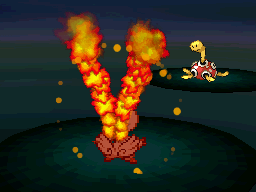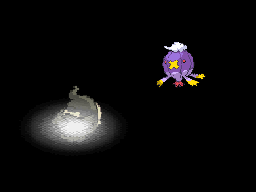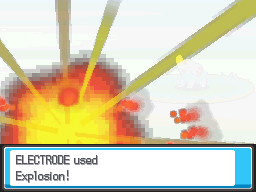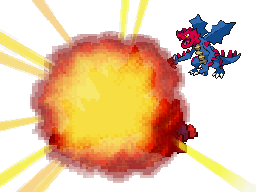HP: Difference between revisions
(Add a section on HP depletion speed so that more people can be informed about its existence and importance.) |
m (Fix capitalization, also please contact me on the bulbagarden discord if there are issues.) |
||
| Line 50: | Line 50: | ||
====HP bar speed==== | ====HP bar speed==== | ||
Up to at least Generation 5, the speed of the HP bar is dependent on a Pokemon's HP. Its relation to HP is different per generation, but the speed is noticeably different between Pokemon with high and low HP stats. The exact mechanics of HP bar speed are unfortunately not well researched, but there has been some done in [[List_of_glitches_(Generation_II)#HP_bar_animation|Generation 2]] by Crystal_ and in [//www.youtube.com/watch?v=Giqb514NgoE Generation 4] by gigalh128. Most of the reason why the HP bar feels slow in | Up to at least Generation 5, the speed of the HP bar is dependent on a Pokemon's HP. Its relation to HP is different per generation, but the speed is noticeably different between Pokemon with high and low HP stats. The exact mechanics of HP bar speed are unfortunately not well researched, but there has been some done in [[List_of_glitches_(Generation_II)#HP_bar_animation|Generation 2]] by Crystal_ and in [//www.youtube.com/watch?v=Giqb514NgoE Generation 4] by gigalh128. Most of the reason why the HP bar feels slow in Generation 4 is because it depletes 1 HP for every 2 frames at 60 FPS (except for the first HP lost, which only takes 1 frame) for Pokemon with more HP than the number of pixels in the HP bar. This leads to Pokemon like Blissey taking over 20 seconds to KO from full health at high levels. | ||
Interestingly, depletion speed can be used to narrow down how much damage an opponent's Pokemon has taken without seeing its actual HP stats. | Interestingly, depletion speed can be used to narrow down how much damage an opponent's Pokemon has taken without seeing its actual HP stats. | ||
Revision as of 13:56, 22 August 2022
- For the move commonly referred to in competitive battling as "HP", see Hidden Power. For the Pokémon Trading Card Game set commonly abbreviated as "HP," see EX Holon Phantoms.
HP (Japanese: HP), short for Hit Point (Japanese: ヒットポイント Hit Point), is a stat that determines how much damage a Pokémon can receive before fainting.
In the core series

|
This article is incomplete. Please feel free to edit this article to add missing information and complete it. Reason: Explain how Dynamax affects HP |
Each Pokémon has a maximum HP value, and the current HP value which is somewhere between 0 (if it has fainted) or the maximum HP (if it has full HP).
As with other stats, a Pokémon's maximum HP usually increases with their level, and is a combination of the Pokémon's base stats, individual values, and effort values. Some Pokémon species tend to have a higher or lower HP than others, and some individual Pokémon may have different HP even if they are of the same species and level. A Pokémon's maximum HP may reach hundreds of points. However, Shedinja is a special case, whose maximum HP is always 1.
A Pokémon needs to have at least 1 HP to be able to battle. If a Pokémon reaches 0 HP, it has fainted. However, a fainted Pokémon can still use field moves outside of battle, such as Cut, Surf, Fly, Headbutt, Sweet Scent, etc.
The player's Pokémon are able to enter into battle with less than full HP if they have not been healed yet. The opposing Pokémon (both wild and owned by NPCs) always start battles with full HP. However, if a roaming Pokémon takes damage and then flees from the current battle, it will still have the same damage (that is, the amount of HP lost) when it is found for the next battle.
In a battle between Trainers, the objective is causing all the opposing Pokémon to reach 0 HP and faint, at which point the battle ends. In a battle against a wild Pokémon, the player may wish to deal some damage to the wild Pokémon and decrease its HP for the purpose of catching it more easily. However, if the wild Pokémon reaches 0 HP and faints, the battle will end and this Pokémon will not be caught.
If all Pokémon in the player's party faint, then the player blacks out. This causes the player to lose a sum of money and be sent to a Pokémon Center (or to the player's house at the start of the game), at which point all of the player's Pokémon will be healed automatically.
HP bar
The current and maximum HP of each Pokémon is usually shown as an horizontal bar, which displays how much HP each Pokémon has; this is visible in a Pokémon battle, as well as in the party and summary screens. Additionally, the player may see exactly the number of current and maximum HP for each of their Pokémon. The Pokémon that are not owned by the player (including Pokémon owned by non-player characters, as well as wild Pokémon) have their HP bars visible in battle as well, but the exact number of their current and maximum HP number is not revealed to the player.
In Generation I, if the HP bar's fill was 27 pixels or wider (out of a total end-to-end length of 48 pixels), it would be colored green; if it was between 10 and 26 pixels, it would be colored yellow; and if it was less than 10 pixels wide, it would be colored red. This means the HP bar turns yellow noticeably earlier than in the later games, or at about 56% of the Pokémon's maximum HP.
From Generation II onwards, if a Pokémon has more than half of its max HP, its HP bar remains green. If the Pokémon has between one-fifth and half of its HP, the bar will turn yellow (in Generation II, a Pokémon revived to exactly half of their HP will have a green HP bar). If a Pokémon has less than one-fifth of its HP remaining, the bar will turn red and a beeping sound (Generations I-IV), a change of battle music with the beep as a metronome (Generation V), or a series of 4 beeping sounds before fading away (since Generation VI) will notify the player that his or her Pokémon is in danger of fainting. Before Generation VI, this beeping will continue until the Pokémon is switched out to another Pokémon which has at least one-fifth of its HP, has its HP raised to one-fifth or higher by any means, or faints.
The HP bar also affects the Pokémon's cry. Since Pokémon Ruby and Sapphire, if a Pokémon's HP bar is green, the player will hear the cry of the Pokémon in its normal sounding rate, but if the Pokémon faints, its cry will be lowered by a whole step. Also, since Pokémon FireRed and LeafGreen, if the Pokémon has less than half its total HP, its cry will be lowered by a half-step to indicate its weakened state.
HP bar speed
Up to at least Generation 5, the speed of the HP bar is dependent on a Pokemon's HP. Its relation to HP is different per generation, but the speed is noticeably different between Pokemon with high and low HP stats. The exact mechanics of HP bar speed are unfortunately not well researched, but there has been some done in Generation 2 by Crystal_ and in Generation 4 by gigalh128. Most of the reason why the HP bar feels slow in Generation 4 is because it depletes 1 HP for every 2 frames at 60 FPS (except for the first HP lost, which only takes 1 frame) for Pokemon with more HP than the number of pixels in the HP bar. This leads to Pokemon like Blissey taking over 20 seconds to KO from full health at high levels.
Interestingly, depletion speed can be used to narrow down how much damage an opponent's Pokemon has taken without seeing its actual HP stats.
The HP bar visibly decreases slower for Drifblim compared to Shuckle in Black/White.
Additionally, while the HP bar immediately drops to zero for the user of a self-KO move like explosion in generations 1-4, this is no longer the case in generation 5+.
Unlike Electrode, Gigalith's HP does not immediately drop to zero upon using explosion.
Losing HP
The most common way for a Pokémon to lose HP is by being hit by a move that deals damage; most physical and special moves can deal damage. However, there are other ways to lose HP, such as making contact to a Pokémon with Iron Barbs, or being hit by a sandstorm.
Moves that cost HP
- Main article: Category:Moves that cost HP to use
There are some moves that cost HP to use.
| Move | Type | Category | HP cost | Power | Accuracy | Notes |
|---|---|---|---|---|---|---|
| Substitute | Normal | Status | 1/4 of maximum HP | — | — | The user creates a substitute, which is targeted by the opponent's next moves in place of the user, as long as the substitute is in battle |
| Clangorous Soul | Dragon | Status | 1/3 of maximum HP | — | — | This move raises the user's Attack, Defense, Special Attack, Special Defense, and Speed by one stage each |
| Belly Drum | Normal | Status | 1/2 of maximum HP | — | — | This move maximizes the user's Attack stat |
| Curse | Ghost | Status | — | — | If the user is Ghost-type, it pays the HP cost and places a curse on the target; the cursed Pokémon loses 1/4 of HP each turn from now on If the user is not Ghost-type, there is no HP cost involved; the user's Speed will drop one stage, while its Attack and Defense will rise one stage each |
Restoring HP
The player may use a Pokémon Center to heal completely heal all the Pokémon in the party (including their HP, PP, and status conditions).
In Generation I, it is possible to start a link battle with Pokémon that have less than full HP if they have not been healed yet. However, all Pokémon are completely healed after each link battle. From Generation II onwards, all Pokémon are automatically healed before all link battles.
In Generations II to VII, if a Pokémon is deposited in the Pokémon Storage System, it is completely healed.
In all core series games, the player's Pokémon are also automatically healed after the first battle against a rival character.
HP-restoring items
- Main article: Category:HP-restoring items
These are the items that restore a Pokémon's HP. Most of these items are consumed when used, except the repeatable items such as Leftovers. Almost all these items only work on Pokémon that are not fainted, except the reviving items at the end of the list.
| Sprite | Name | HP restored by generation | Method of use | Notes | |||||||||||
|---|---|---|---|---|---|---|---|---|---|---|---|---|---|---|---|
| I | II | III | IV | V | VI | VII | VIII | Bag | Held item | ||||||
| Berry | — | 10 | — | ✔ | ✔ | ||||||||||
| Oran Berry | — | 10 | ✔ | ✔ | |||||||||||
| Potion | 20 | ✔ | ✘ | Increases the starter Pikachu's friendship in Pokémon Yellow | |||||||||||
| Berry Juice | — | 20 | ✔ | ✔ | |||||||||||
| Rage Candy Bar | — | 20 | — | 20 | — | ✔ | ✘ | In Pokémon HeartGold and SoulSilver, this is a Key Item that can be exchanged for TM64 (Explosion) From Generation VII onwards, this item heals status conditions | |||||||
| Sweet Heart | — | 20 | ✔ | ✘ | |||||||||||
| Gold Berry | — | 30 | — | ✔ | ✔ | ||||||||||
| Sitrus Berry | — | 30 | ¼ | ✔ | ✔ | ||||||||||
| Fresh Water | 50 | 30 | ✔ | ✘ | |||||||||||
| Super Potion | 50 | 60 | ✔ | ✘ | Increases the starter Pikachu's friendship in Pokémon Yellow | ||||||||||
| Energy Powder | — | 50 | 60 | ✔ | ✘ | Lowers friendship | |||||||||
| Soda Pop | 60 | 50 | ✔ | ✘ | |||||||||||
| Lemonade | 80 | 70 | ✔ | ✘ | |||||||||||
| Moomoo Milk | — | 100 | ✔ | ✘ | |||||||||||
| Hyper Potion | 200 | 120 | ✔ | ✘ | Increases the starter Pikachu's friendship in Pokémon Yellow | ||||||||||
| Energy Root | — | 200 | 120 | ✔ | ✘ | Lowers friendship | |||||||||
| Aguav Berry | — | ⅛ | ½ | ⅓ | ✔ | ✔ | Confuses a Pokémon that dislikes the bitter flavor | ||||||||
| Figy Berry | — | ⅛ | ½ | ⅓ | ✔ | ✔ | Confuses a Pokémon that dislikes the spicy flavor | ||||||||
| Iapapa Berry | — | ⅛ | ½ | ⅓ | ✔ | ✔ | Confuses a Pokémon that dislikes the sour flavor | ||||||||
| Mago Berry | — | ⅛ | ½ | ⅓ | ✔ | ✔ | Confuses a Pokémon that dislikes the sweet flavor | ||||||||
| Wiki Berry | — | ⅛ | ½ | ⅓ | ✔ | ✔ | Confuses a Pokémon that dislikes the dry flavor | ||||||||
| Enigma Berry | — | ¼ | ✘ | ✔ | Restores the holder's HP when hit by a super effective move | ||||||||||
| Max Potion | Full | ✔ | ✘ | Increases the starter Pikachu's friendship in Pokémon Yellow | |||||||||||
| Full Restore | Full | ✔ | ✘ | Fully restores a Pokémon, including its HP, and status conditions Increases the starter Pikachu's friendship in Pokémon Yellow | |||||||||||
| Heal Ball | — | Full | ✔ | ✘ | Fully restores a wild Pokémon that was caught with this item and sent to the party (as opposed to the Storage System, in which all Pokémon are fully healed regardless of the type of Poké Ball) | ||||||||||
| Repeatable items | |||||||||||||||
| Leftovers | — | 1/16 (rounded down, minimum 1 HP) |
✘ | ✔ | Restores the holder's HP at the end of each turn | ||||||||||
| Black Sludge | — | 1/16 (rounded down, minimum 1 HP) |
✘ | ✔ | If the holder is Poison-type, restores the holder's HP at the end of each turn If the holder is not Poison-type, the holder takes damage | ||||||||||
| Shell Bell | — | 1/8 of damage dealt to the target (rounded down, minimum 1 HP) |
✘ | ✔ | Restores the holder's HP when the holder deals damage with a move | ||||||||||
| Reviving items | |||||||||||||||
| Rare Candy | the amount of HP gained when leveling up, otherwise 2 HP (except a fainted Shedinja revives with 1 HP) |
✔ | ✘ | It increases a Pokémon's level, up to level 100 The Pokémon may gain some HP as a natural result of leveling up It can be used to revive a fainted Pokémon with little HP | |||||||||||
| Revive | Half | ✔ | ✘ | ||||||||||||
| Max Revive | Full | ✔ | ✘ | ||||||||||||
| Revival Herb | — | Full | HalfRS FullFRLGE |
Full | ✔ | ✘ | Lowers friendship | ||||||||
| Sacred Ash | — | Full | ✔ | ✘ | This item can only be used outside of battle In Generation II, fully restores all Pokémon in the party, provided there is at least one fainted Pokémon From Generation III onwards, fully restores all fainted Pokémon | ||||||||||
HP-restoring moves
- Main article: Category:Moves that restore HP
These are moves that restore HP.
| Move | Type | Category | HP restored | Power | Accuracy | Notes | |
|---|---|---|---|---|---|---|---|
| User | Other Pokémon | ||||||
| Heal Order | Bug | Status | 50% of maximum HP | — | — | —% | |
| Purify | Poison | Status | — | —% | Heals the user's HP, provided it also heals the target's status condition | ||
| Recover | Normal | Status | — | —% | |||
| Roost | Flying | Status | — | —% | A Flying-type user becomes grounded while using this move | ||
| Slack Off | Normal | Status | — | —% | |||
| Wish | Normal | Status | — | —% | Heals the user (or the Pokémon in the user's current position) on the next turn | ||
| Milk Drink | Normal | Status | 50% of maximum HP (in battle) |
20% of user's HP (outside of battle) |
— | —% | These moves heal the user in battle They are also used outside of battle to transfer HP from the user to another non-fainted Pokémon in the party |
| Soft-Boiled | Normal | Status | — | —% | |||
| Shore Up | Ground | Status | ½ (outside of a sandstorm) ⅔ (during a sandstorm) |
— | — | —% | |
| Moonlight | Fairy | Status | Varies depending on the weather In Generation II only, it also depends on the time |
— | —% | Prior to Generation VI, it was a Normal-type move | |
| Morning Sun | Normal | Status | — | —% | |||
| Synthesis | Grass | Status | — | —% | |||
| Rest | Psychic | Status | Full HP | — | —% | The user starts sleeping once this move is used | |
| Aqua Ring | Water | Status | 1/16 of maximum HP | — | —% | Once any of these moves is used, the user is healed automatically at the end of every turn Ingrain roots the user to the ground, preventing its escape | |
| Ingrain | Grass | Status | — | —% | |||
| Jungle Healing | Grass | Status | 25% of maximum HP | — | —% | Heals the user, as well as its allies | |
| Life Dew | Water | Status | — | —% | |||
| Grassy Terrain | Grass | Status | 1/16 of maximum HP | — | —% | As long as this this terrain is in effect, grounded Pokémon are healed automatically at the end of every turn | |
| Leech Seed | Grass | Status | 1/16 of seeded Pokémon's HP (Generation I) 1/8 of seeded Pokémon's HP (Generation II onwards) |
— | — | 90% | Once Leech Seed is used, the target becomes seeded and it takes damage at the end of every turn The user (or another Pokémon in the same place) restores the same amount of HP as the damage dealt If the seeded Pokémon has Liquid Ooze, the user is damaged instead of healed In Generation I only, this move's damage is calculated in the same way as Toxic, and only if Toxic is currently applied to the target. |
| Absorb | Grass | Special | 50% of damage dealt | 20 | 100% | These moves deal damage on the target and restore the user's HP Dream Eater only works if the target is asleep If the target has Liquid Ooze, the user is damaged instead of healed | |
| Mega Drain | Grass | Special | 40 | 100% | |||
| Parabolic Charge | Electric | Special | 65 | 100% | |||
| Drain Punch | Fighting | Physical | 75 | 100% | |||
| Giga Drain | Grass | Special | 75 | 100% | |||
| Horn Leech | Grass | Physical | 75 | 100% | |||
| Leech Life | Bug | Physical | 80 | 100% | |||
| Bouncy Bubble | Water | Special | 90 | 100% | |||
| Dream Eater | Psychic | Special | 100 | 100% | |||
| Draining Kiss | Fairy | Special | 75% of damage dealt | 50 | 100% | ||
| Oblivion Wing | Flying | Special | 80 | 100% | |||
| Strength Sap | Grass | Status | The target's Attack | — | 100% | This move lowers the target's Attack by one stage It also restores the user's HP by the same amount as the target's effective Attack stat before Strength Sap was used If the target has Liquid Ooze, the user is damaged instead of healed | |
| G-Max Finale | Fairy | — | 1/6 of maximum HP | — | —% | Deals damage to the target; its category and power depend on the move it is based on Heals the user as well as its allies | |
| Floral Healing | Fairy | Status | — | ½ (outside of Grassy Terrain) ⅔ (with Grassy Terrain) |
— | —% | Heals the target's HP |
| Heal Pulse | Psychic | Status | 50% of maximum HP | — | —% | ||
| Pollen Puff | Bug | Special | 90 | 100% | Heals the target's HP when used on an ally Deals damage when used on a foe Pokémon with Bulletproof are immune to this move | ||
| Present | Normal | Physical | 25% of maximum HP | — | 90% | This move has a chance of either dealing damage or healing the target's HP | |
| Healing Wish | Psychic | Status | Full HP | — | —% | The user faints; the next Pokémon is completely healed, with full HP | |
| Lunar Dance | Psychic | Status | — | —% | |||
| Pain Split | Normal | Status | Varies | — | —% | This move splits the current HP between the user and the target | |
In spin-off games
Trading Card Game series
- Main article: HP (TCG) → Trading Card Game series
In the anime
Main series
Hit Points have only ever been mentioned in the anime once. Specifically, they were mentioned by Misty in Fire and Ice, and even then, this mention only exists in the dubbed version.
Pokémon Origins
As first seen in File 1: Red, facilities like Gyms and the Pokémon League feature screens that display a Pokémon's HP in the form a bar, similar to the games.
In the manga
Pokémon Adventures
HP has been mentioned several times throughout Pokémon Adventures, the first mention occurring in Wanted: Pikachu!. In Just a Spearow Carrier, an HP bar similar to the games was seen at Indigo Plateau.
In the TCG

- Main article: HP (TCG)
The Pokémon cards have an HP (Japanese: HP) value at the top-right corner. It represents the health of each Pokémon card and the amount of damage it can take before being Knocked Out.

|
This game mechanic article is part of Project Games, a Bulbapedia project that aims to write comprehensive articles on the Pokémon games. |







